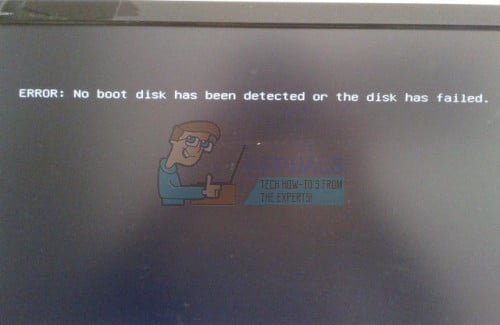Fix: No Boot Disk Has Been Detected or the Disk Has Failed
When a computer boots up, it checks the HDD/SSD for boot information and an Operating System and acts on the information retrieved to boot up the Operating System it found on the disk. However, if a computer, for some reason, is unable to find an Operating System and/or valid boot information on its HDD/SSD, you may see the following error message on your screen:
“No boot disk has been detected or the disk has failed”
Obviously, this error message is displayed when the affected computer is unable to find any boot information or Operating System on its HDD/SSD. However, an affected computer may have been unsuccessful at finding boot information and/or an Operating System on its HDD/SSD because of a variety of different reasons – from the computer’s HDD/SSD not being appropriately connected or the disk failing or starting to fail (yes, both HDDs and SSDs can start to fail over time) to the HDD/SSD that contains the boot information not being on top of the computer’s boot order or the drive not having any boot information at all due to the Operating System being wiped (either intentionally or, as in most cases, unintentionally).

No matter what the cause of this error message being displayed in your case is, however, the following are some of the most effective solutions that you can use to try and fix this issue:
Solution 1: Make sure that the computer’s HDD/SSD is appropriately connected
If the connection between a computer and its HDD/SSD is somehow knocked loose, the computer will not be able to access it in order to retrieve boot information, resulting in the “No boot disk has been detected or the disk has failed” error message being displayed at boot. To rule this out as a possibility, simply open up your computer’s casing (this may require a certain degree of care if you’re dealing with a laptop), disconnect the drive from the computer, clean out all connections and ports and reconnect the drive to the computer, making sure that all connections between the two are securely seated. Once you’re done, simply boot the computer up and check to see if the problem persists.
Solution 2: Check to see if the drive is failing
There is a strong possibility that this problem might be caused by a failing HDD/SSD, especially since the error message itself says that the boot disk may have failed. The easiest way to check whether or not an HDD/SSD is failing is to connect it to another, already booted up computer and check to see whether or not you can successfully access its contents. However, if the HDD/SSD is still in warranty, you might want to send it back to the manufacturer to have it looked at just in case.
Solution 3: Ensure that the boot disk is at the top of the computer’s boot order
You may be seeing the “No boot disk has been detected or the disk has failed” error message on boot because your computer is trying to boot from another source and failing to find any boot information instead of booting from the boot disk. If that’s the case, all you need to do in order to resolve this problem is to ensure that the boot disk is at the top of your computer’s boot order. In order to do so, you need to:
- Start your computer up.
- On the first screen that you see when your computer boots up, you will find instructions to press a specific key – which, in most cases, is Delete, F1 or F2 – to enter your computer’s BIOS/Setup. Press the key specified to enter the BIOS.
- In the BIOS, locate your computer’s boot order/configuration. In most cases, the boot order is located under the BIOS’s Boot
- Adjust the boot order so that the HDD/SSD that is the boot disk is at the top, meaning that the computer tries to retrieve boot information from it before any other sources.
- Exit the computer’s BIOS, but be sure to save the changes that you have made to it before doing so.

When you exit the BIOS, the computer will restart. Check to see whether or not the issue has been fixed as the computer tries to boot up.
Solution 4: Clean install Windows
If none of the solutions listed and described above work for you and you are certain that the affected computer’s boot disk has not failed, you may be suffering from this problem because the Operating System and/or boot information that the boot disk contained was somehow erased (either intentionally/unintentionally be the user or as a consequence of some other happening).
If that’s the case, your best bet at resolving this problem is (clean) installing Windows from scratch. However, be warned – clean installing any version of the Windows Operating System will result in the loss of all or most of the data stored on the affected computer’s HDD/SSD. But at the end of the day, a working computer with no data is much better than a computer that has all of your data but doesn’t work. You can use this guide to clean install Windows 10 – the latest and greatest iteration of the Windows Operating System.